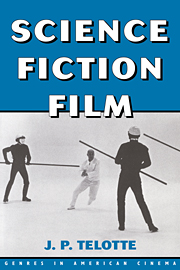Book contents
- Frontmatter
- Contents
- List of Illustrations
- Acknowledgments
- PART I APPROACHES
- 1 Introduction: The World of the Science Fiction Film
- 2 Science Fiction Film: The Critical Context
- PART II HISTORICAL OVERVIEW
- PART III FILM ANALYSES
- Notes
- Bibliography
- Select Filmography of the American Science Fiction Film
- Index
2 - Science Fiction Film: The Critical Context
Published online by Cambridge University Press: 03 December 2009
- Frontmatter
- Contents
- List of Illustrations
- Acknowledgments
- PART I APPROACHES
- 1 Introduction: The World of the Science Fiction Film
- 2 Science Fiction Film: The Critical Context
- PART II HISTORICAL OVERVIEW
- PART III FILM ANALYSES
- Notes
- Bibliography
- Select Filmography of the American Science Fiction Film
- Index
Summary
Although science fiction literature, even in its early years, was often taken fairly seriously and rapidly built up a volume of significant critical material, the science fiction film has taken much longer to find a similar degree of critical acceptance and to develop its own body of commentary. Writing in 1972, for example, William Johnson felt it necessary to introduce his critical anthology Focus on the Science Fiction Film by acknowledging that the sort of attention he and his fellow contributors were according to the genre “is still not fully respectable,” in large part because too many of the films, with their frequent emphasis on bug-eyed monsters (or BEMs) and spectacular, science-induced calamities, seemed to occupy what he termed a “more dubious position” in the world of cinema. That position has changed radically since his book, with the science fiction genre producing a number of the highest-grossing films of all time – among them, Star Wars (1977), E.T. the Extra-Terrestrial (1982), and Star Wars: Episode I – The Phantom Menace (1999) – as well as a variety of critically acclaimed works, including Blade Runner (1982), RoboCop (1987), and Terminator 2: Judgment Day (1991). As a result, science fiction film criticism has moved far afield from its early fanzine-type commentary, such as was found in a magazine like Famous Monsters of Filmland, and large-format picture-book histories, to include articles in the leading literary and film-related journals, as well as university-press-sponsored studies of individual films, filmmakers, and specific themes of science fiction cinema.
- Type
- Chapter
- Information
- Science Fiction Film , pp. 33 - 60Publisher: Cambridge University PressPrint publication year: 2001



